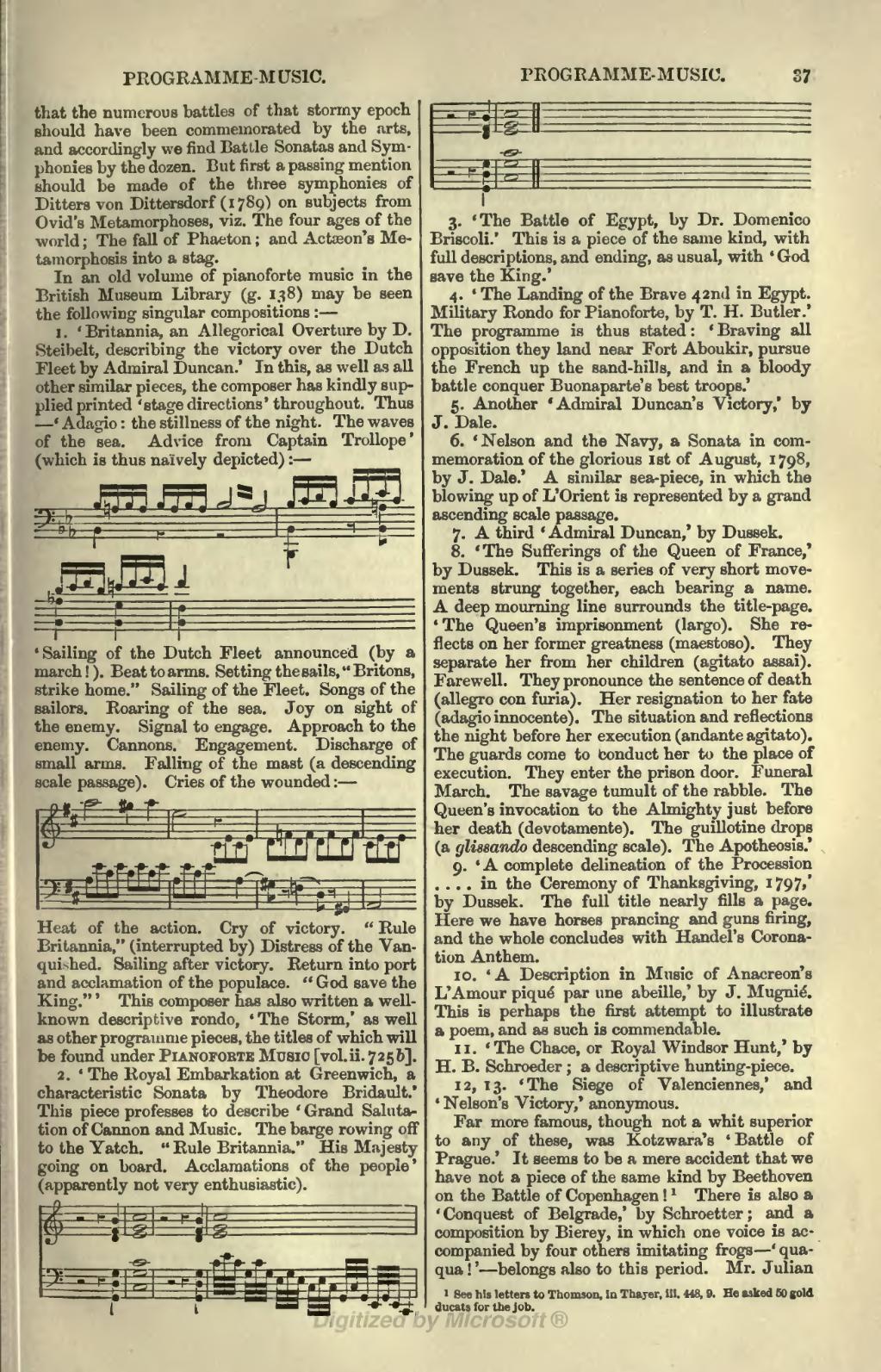the numerous battles of that stormy epoch should have been commemorated by the arts, and accordingly we find Battle Sonatas and Symphonies by the dozen. But first a passing mention should be made of the three symphonies of Ditters von Dittersdorf (1789) on subjects from Ovid's Metamorphoses, viz. The four ages of the world; The fall of Phaeton; and Actæon's Metamorphosis into a stag.
In an old volume of pianoforte music in the British Museum Library (g. 138) may be seen the following singular compositions:—
1. 'Britannia, an Allegorical Overture by D. Steibelt, describing the victory over the Dutch Fleet by Admiral Duncan.' In this, as well as all other similar pieces, the composer has kindly supplied printed 'stage directions' throughout. Thus 'Adagio: the stillness of the night. The waves of the sea. Advice from Captain Trollope' (which is thus naïvely depicted):—

'Sailing of the Dutch Fleet announced (by a march!). Beat to arms. Setting the sails, "Britons, strike home." Sailing of the Fleet. Songs of the sailors. Roaring of the sea. Joy on sight of the enemy. Signal to engage. Approach to the enemy. Cannons. Engagement. Discharge of small arms. Falling of the mast (a descending scale passage). Cries of the wounded:—

Heat of the action. Cry of victory. "Rule Britannia," (interrupted by) Distress of the Vanquished. Sailing after victory. Return into port and acclamation of the populace. "God save the King."' This composer has also written a well-known descriptive rondo, 'The Storm,' as well as other programme pieces, the titles of which will be found under Pianoforte Music [vol. ii. 725b].
2. 'The Royal Embarkation at Greenwich, a characteristic Sonata by Theodore Bridault.' This piece professes to describe 'Grand Salutation of Cannon and Music. The barge rowing off to the Yatch. "Rule Britannia." His Majesty going on board. Acclamations of the people' (apparently not very enthusiastic).
![<< \override Score.TimeSignature #'stencil = ##f \override Score.Rest #'style = #'classical \new Staff { \relative b' { \repeat unfold 3 { r2 r4 <b f d> | <c g e>1 } } }
\new Staff { \clef bass \relative g { r2 r4 <g d g,>4 | <c g c,>1 | r2 r4 <g d g,> | c32*4/3[ e c] g[ c g] e[ g e] c[ e c] g[ c g] e[ g e] c4 | r2 r4 <g' d' g> | <c g' c>1 \bar "||" } } >>](http://upload.wikimedia.org/score/h/k/hk5th6glwfqbgp3mrkpkc4mnoqbki0y/hk5th6gl.png)
3. 'The Battle of Egypt, by Dr. Domenico Briscoli.' This is a piece of the same kind, with full descriptions, and ending, as usual, with 'God save the King.'
4. The Landing of the Brave 42nd in Egypt. Military Rondo for Pianoforte, by T. H. Butler.' The programme is thus stated: 'Braving all opposition they land near Fort Aboukir, pursue the French up the sand-hills, and in a bloody battle conquer Buonaparte's best troops.'
5. Another 'Admiral Duncan's Victory,' by J. Dale.
6. 'Nelson and the Navy, a Sonata in commemoration of the glorious 1st of August, 1798, by J. Dale.' A similar sea-piece, in which the blowing up of L'Orient is represented by a grand ascending scale passage.
7. A third 'Admiral Duncan,' by Dussek.
8. 'The Sufferings of the Queen of France,' by Dussek. This is a series of very short movements strung together, each bearing a name. A deep mourning line surrounds the title-page. 'The Queen's imprisonment (largo). She reflects on her former greatness (maestoso). They separate her from her children (agitato assai). Farewell. They pronounce the sentence of death (allegro con furia). Her resignation to her fate (adagio innocente). The situation and reflections the night before her execution (andante agitato). The guards come to conduct her to the place of execution. They enter the prison door. Funeral March. The savage tumult of the rabble. The Queen's invocation to the Almighty just before her death (devotamente). The guillotine drops (a glissando descending scale). The Apotheosis.'
9. 'A complete delineation of the Procession … in the Ceremony of Thanksgiving, 1797,' by Dussek. The full title nearly fills a page. Here we have horses prancing and guns firing, and the whole concludes with Handel's Coronation Anthem.
10. 'A Description in Music of Anacreon's L'Amour piqué par une abeille,' by J. Mugnié. This is perhaps the first attempt to illustrate a poem, and as such is commendable.
11. 'The Chace, or Royal Windsor Hunt,' by H. B. Schroeder; a descriptive hunting-piece.
12. 13. 'The Siege of Valenciennes,' and 'Nelson's Victory,' anonymous.
Far more famous, though not a whit superior to any of these, was Kotzwara's 'Battle of Prague.' It seems to be a mere accident that we have not a piece of the same kind by Beethoven on the Battle of Copenhagen![1] There is also a 'Conquest of Belgrade,' by Schroetter; and a composition by Bierey, in which one voice is accompanied by four others imitating frogs—'quaqua!'—belongs also to this period. Mr. Julian
- ↑ See his letters to Thomson, in Thayer, iii. 448, 9. He asked 50 gold ducats for the job.
